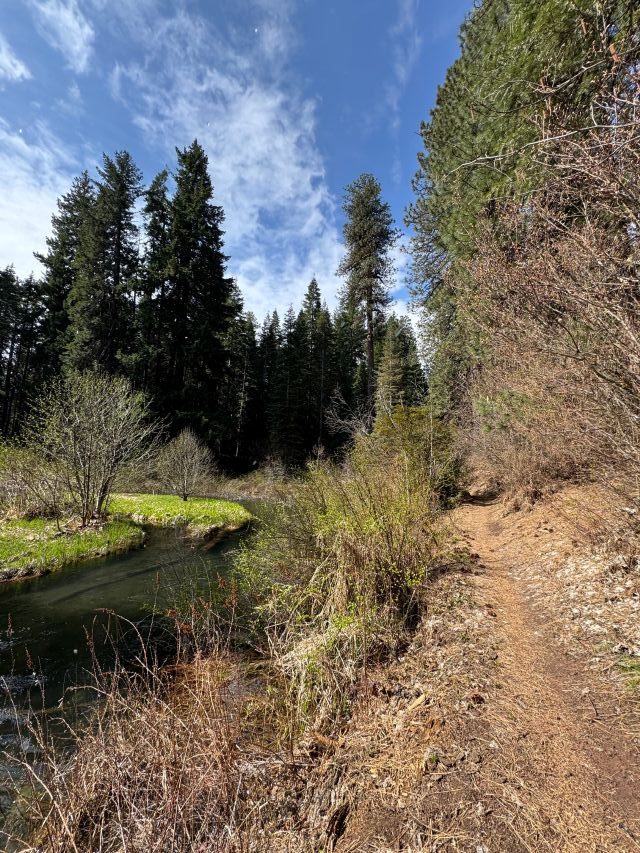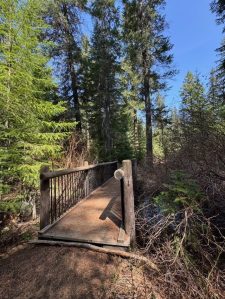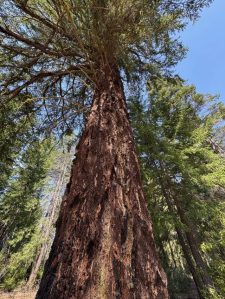Silence awaits among the pines on the Lake Creek Trail
Published 2:16 pm Saturday, May 17, 2025

- Lake Creek (next to the Lake Creek Trail) dribbles from Suttle Lake and heads east toward the Metolius River. Sockeye and Chinook salmon travel with it, some returning to spawn after years in the Pacific Ocean, hundreds of meandering miles away. (Jeremy Dickman)
If an alien lands on earth, holds a plasma gun to your head and demands a hike in one of Earth’s prototypical forests, you could do far worse than to recommend the Lake Creek Trail.
Central Oregon contains numerous examples of trails that traverse different eco-systems over short distances (Swampy Lakes, Metolius-Windigo, Green Lakes, et al). Unlike those trails, the Lake Creek Trail traverses different natural worlds without thousands of feet in elevation changes. It offers stretches of parched grasses framed by towering ponderosa pines. It then bleeds into miles of mossy Douglas fir canopy shading a babbling creek. It bisects the Metolius Preserve, managed by the Deschutes Land Trust. Here, the preserve shelters hundreds of other species of birds, insects and mammals.

The Metolius Preserve is home to a variety of large fauna and flora, from black bears to woodpeckers, from ponderosa pines to the astonishingly rare Peck’s penstemon wildflower. (Jeremy Dickman)
In short, the Lake Creek Trail is a mellow highway that carries you to different natural worlds.
Easy goes it
Hardly an aerobic lift, the biggest challenge you face with the Lake Creek Trail is deciding where to start, and what mode of transportation to choose. Provided you keep your bicycle and your horse off the side trails in the Metolius Preserve, two-wheeling (or four-hoofing) is probably the best option.
My 2-year-old Labrador retriever, Tilly, and I parked on the east end of the trail, near Camp Sherman, and hoofed it — horseless — 9 total miles on a pleasantly mild Saturday morning in April. While Tilly is young, energetic and gathers energy with each step, I’m 46, with increasingly fragile knees. My next trip to this trail will include a mountain bike.
From the Camp Sherman end of the trail, you begin among a recently thinned ponderosa pine forest. Silence greets you first, and the effect is welcome. As with most outdoor hikes in unfamiliar areas, I left the earbuds at home. I recommend this in the wild areas of Central Oregon, not just because it’s better for your mental health, but also because it’s useful to know when a curious bear or cougar is afoot.
Unencumbered ears will also introduce you to a pleasant cacophony of birds, chipmunks, running water, and trees creaking in the wind. I’m nowhere near a birder, but I recognized the distinct report of multiple woodpeckers, several ravens, and innumerable songbirds. For those without a Headspace subscription on your phone, this is as close to guided meditation as you may get.
Nearer to Camp Sherman, the blackened remains of trees and stumps reflect prescribed burns of years past. Human management of the forest didn’t stop there; many dead or dying trees were purposefully topped or toppled to create decaying snags, logs and stumps. These wooden corpses are crucial for thousands of species of insects and small rodents, and as nurseries for plant species.
Roughly 1.5 miles into the hike, you will arrive at the Metolius Preserve. It is well worth a detour to explore the trails in the preserve. Unlike much of our forested areas, this isn’t a glorified tree farm, managed by the USDA for its resources. This is a truly wild area, untouched by motorized traffic, horses or bicycles (keep your pet leashed in this sensitive area).
Rare flora
The Metolius Preserve is also home to one of the rarest plant species on earth, the Peck’s penstemon. This pink flower grows nowhere else in the world except for Camp Sherman and the Trout Creek Conservation Area adjacent to Sisters High School.

An enormous Douglas fir shades some very coveted campsites along the Lake Creek Trail. (Jeremy Dickman)
More bugs, more birds, and more wonderfully chaotic nature result from preserving wild spaces. The Deschutes Land Trust’s website claims that bobcats, black bears, otters, elk, badgers and beavers, among other mammals, call the 1,240-acre preserve home. I hiked in late April, but now and later this spring you may be treated to a more colorful menagerie of wildflowers in the preserve, including columbine and, of course, the elusive Peck’s penstemon.
I saw no large mammals on my trip, but that could be a result of my four-legged companion. She means well, but she’s a downright obnoxious, drooling blowhard, even on a leash. If your primary goal is to spot shy wildlife, consider leaving your best friend at home, just this once.
As Tilly and I briskly continued our jaunt westward, the forest turned darker. Massive Douglas firs shaded the trail. It was here that we first heard Lake Creek itself. The waterway is a migratory route for sockeye and Chinook salmon, to and from Suttle Lake. Lake Creek spills from Suttle Lake into the Metolius and eventually into Lake Billy Chinook before its waters are carried to the Columbia River.
If you are hiking from east to west, this is where you reach your first elevation gains of the trip. The trail crosses Jack Lake Road, but mercifully travels underneath a bridge on U.S. Highway 20, alongside Lake Creek, just before you reach Suttle Lake.
Getting there
From Bend, you can reach the Lake Creek Trailhead by traveling north on Highway 20 and taking the turnoff to Suttle Lake about 12 miles northwest of Sisters. The trailhead begins near the day-use area at the east shore of the lake. If you prefer a Camp Sherman start, take the turnoff from Highway 20 onto Camp Sherman Road, about 8 miles northwest of Sisters. The trailhead is well marked, about ½ mile north of the Camp Sherman Community Hall, just off Camp Sherman Road on the left.
On a return trip, I would recommend a west-to-east route, perhaps with a turnaround at the Metolius Preserve. This would result in a more reasonable five-mile hike, as opposed to the borderline irresponsible 9-mile out-and-back that I chose. I can only assume that armed aliens are more likely to let you live if their knees aren’t throbbing.






